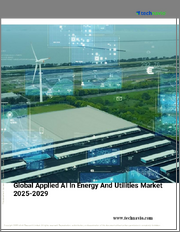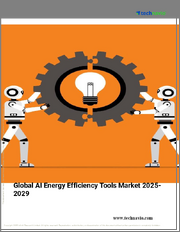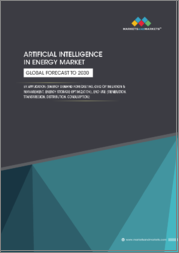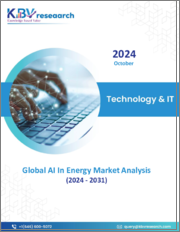
|
시장보고서
상품코드
1551309
세계의 에너지용 AI 시장 예측 : 컴포넌트 유형별, 전개 유형별, 용도별, 최종 사용자별, 지역별 분석(-2030년)AI in Energy Market Forecasts to 2030 - Global Analysis By Component Type (Hardware, Solutions and Services), Deployment Type (On-premise and Cloud-based), Application, End User and by Geography |
||||||
Stratistics MRC에 따르면 세계의 에너지용 AI 시장은 2024년에 68억 1,000만 달러로 추정되고, 예측 기간 중 CAGR은 19.4%로 성장할 전망이며, 2030년에는 197억 3,000만 달러에 달할 것으로 예측되고 있습니다.
인공지능(AI)은 비용 절감, 효율 향상 및 공정 최적화를 통해 에너지 산업을 변화시키고 있습니다. 인공지능(AI) 기술은 배전망 관리를 개선하고, 에너지 수요를 예측하고, 에너지 생산을 극대화하는 데 사용됩니다. AI는 고급 알고리즘과 머신러닝을 사용하여 센서 및 스마트 그리드의 대량 데이터를 분석하여 에너지 소비 패턴을 예측하고 공급을 실시간으로 조정할 수 있습니다. 또한 신재생 에너지의 변동을 제어하고 에너지의 안정적인 공급을 보장함으로써 AI는 신재생 에너지를 송전망에 통합하는데 중요한 역할을 합니다.
국제에너지기구(IEA)에 의하면, 에너지용 AI의 채용은 에너지 효율의 대폭적인 개선으로 이어지고, 변화하는 수요 및 공급 상황에 실시간으로 적응할 수 있는 보다 스마트한 에너지 시스템을 실현할 가능성이 있습니다.
증가하는 에너지 효율에 대한 관심
세의계 에너지 소비량이 증가하는 길을 따라가면서 보다 효과적인 에너지 관리에 대한 수요가 높아지고 있습니다. 이 수요에 부응하기 위한 선도역이 되고 있는 것이 인공지능(AI) 기술입니다. 인공지능(AI)은 에너지 소비 패턴을 예측하고, 에너지 출력을 극대화하고, 쓸데없는 에너지 지출을 줄이는 도구를 제공합니다. 인공지능(AI)은 머신러닝 알고리즘을 사용하여 에너지 시스템의 비효율성을 인식하고 수정을 제안하며 수요 변동에 자동 반응을 시작할 수 있습니다. 또한 수중에 있는 자원을 최대한 활용함으로써 에너지 공급자의 운영 비용을 낮출 뿐만 아니라 온실가스 배출 감축을 위한 세계의 노력에도 기여합니다.
엄청난 도입 비용
에너지 부문은 인공지능(AI)으로부터 큰 혜택을 받을 수 있지만, 많은 조직(특히 소규모의 유틸리티 사업자 및 에너지회사)은 AI기술을 도입하기 위한 초기 비용이 손에 닿지 않는 것 라고 느낄지도 모릅니다. AI 통합에는 소프트웨어, 하드웨어 및 유능한 노동력에 상당한 투자가 필요합니다. 현재 인프라 업그레이드, 데이터 과학자 및 인공지능 전문가의 고용 및 교육에 대한 투자, 최첨단 센서 및 데이터 처리 장비를 구입하는 등 기업에 필요한 모든 것을 고려할 수 있습니다. 또한 AI 알고리즘은 특정 에너지 용도에 맞게 맞춤화해야 하며, 이를 생성하고 유지하는 데 비용이 많이 듭니다.
AI를 활용한 예지보전시스템 구축
AI를 활용한 예지보전과 관련하여 에너지 부문은 많은 가능성을 가지고 있습니다. 발전소, 송전선, 신재생 에너지 설비 등의 에너지 인프라의 상태를 항상 감시함으로써, 인공지능(AI)은 고장이 일어나기 전에 유지보수의 필요성을 예측할 수 있습니다. 유지 보수 비용을 줄이는 것 외에도 자산의 수명이 연장되고 가동 중지 시간이 줄어 듭니다. 또한, 예지보전에 있어서의 AI의 활용은 운용의 유효성을 높일 뿐만 아니라 에너지의 생성과 공급에 있어서의 안전성과 신뢰성도 높입니다.
사이버 보안에 대한 위협 및 위험
에너지 부문이 AI에 대한 의존도를 높이는 것과 관련하여 큰 사이버 보안 위험이 존재합니다. 인공지능(AI) 시스템은 발전소, 배전망, 에너지 그리드를 제어하는 데 점점 더 중요해지고 있습니다. AI 주도의 에너지 시스템이 공격에 성공하면 광범위한 정전이나 중요 인프라에 대한 피해, 심지어 국가 안보에 대한 위협이 발생할 수 있습니다. 해커는 AI 알고리즘을 변경하여 장비 오작동을 일으키거나 에너지 배급을 위험에 빠뜨리고 기밀 정보를 훔칠 수 있습니다. 게다가 에너지 시스템이 보다 디지털적으로 통합되어 의존성이 높아짐에 따라 공격 대상은 확대되고 사이버 공격에 대한 방어의 난이도는 높아집니다.
COVID-19의 영향 :
COVID-19 팬데믹은 에너지의 인공지능(AI) 시장에 큰 영향을 미쳤습니다. 공급망 혼란, 프로젝트 지연, 봉쇄 및 경제 성장 둔화로 인한 에너지 수요의 일시적인 침체를 일으켰습니다. 그러나 에너지 기업이 업무의 합리화, 원격 감시 능력의 향상, 장래의 충격에 대한 대비를 모색하는 가운데, 팬데믹은 인공지능(AI)을 포함한 디지털 기술의 채용을 앞당기기도 했습니다. 게다가 보다 효과적인 에너지관리와 재생가능에너지원의 통합의 필요성이 더욱 높아지면서 AI 솔루션에 대한 관심이 위기 중에 높아졌습니다.
예측 기간 동안 하드웨어 부문이 최대가 될 것으로 예상
에너지용 AI 시장에서는 하드웨어 분야가 가장 큰 점유율을 차지할 것으로 예측됩니다. 이 부문에는 센서, CPU, 스토리지 및 기타 중요한 인프라와 같은 AI 시스템을 구현하는 데 필요한 부품이 포함됩니다. 에너지 관리, 스마트 그리드 및 신재생 에너지 통합의 AI 용도는 안정적인 데이터 수집, 실시간 처리 및 스토리지 기능을 필요로 하므로 정교한 하드웨어가 필요합니다. 게다가 에너지 기업은 AI 주도형 솔루션의 채용을 늘리고 있기 때문에 현재 시장의 지배적인 부문이 되고 있으며, 이것이 정교한 고성능 하드웨어 수요를 밀어 올리고 있습니다.
예측 기간 동안 클라우드 기반 부문이 가장 높은 CAGR 예측
에너지용 AI 시장의 클라우드 기반 솔루션 부문은 CAGR이 가장 높습니다. 합리적인 가격, 확장성, 유연성으로 클라우드 컴퓨팅의 인기가 높아지고 있는 것이 이 성장의 주요 요인입니다. 에너지 기업은 클라우드 기반 AI 플랫폼을 통해 온프레미스의 많은 인프라를 필요로 하지 않고도 대량의 데이터와 정교한 알고리즘을 이용할 수 있게 되었습니다. 또한 클라우드 솔루션은 지리적 경계를 넘어서는 협업을 지원하고 이기종 데이터 소스의 통합을 가능하게 하기 위해 복잡한 에너지 시스템을 관리하고 에너지 최적화 및 예지 보전과 같은 분야에서 혁신 홍보에 특히 매력적입니다.
최대 점유율을 차지하는 지역
에너지용 AI 시장에서 북미는 가장 큰 점유율을 차지합니다. 에너지 부문이 확립되어 있는 것, 연구개발에 다액의 투자를 실시하고 있는 것, 최첨단의 기술 인프라를 가지고 있는 것 등이, 이 우위성의 이유입니다. AI 기술의 채용은 북미, 특히 미국에서 주요 기업이 되고 있지만, 이것은 관민으로부터의 다액의 자금 제공, 대기업 기술 회사나 독창적인 신흥 기업의 강력한 존재에 의한 것입니다. 게다가 이 지역에서는 인프라의 현대화, 신재생 에너지원의 통합, 에너지효율의 향상이 중시되어 AI 솔루션 수요가 높습니다.
CAGR이 가장 높은 지역 :
에너지용 AI 시장은 아시아태평양에서 가장 높은 CAGR로 성장하고 있습니다. 이 지역의 산업화의 진전, 에너지 인프라 투자 증가, 에너지 효율의 개선과 재생 가능 에너지원의 도입을 목적으로 한 주요 정부 프로그램이 이 급성장의 주요 원동력이 되고 있습니다. 증가하는 에너지 수요를 충족하고 에너지 시스템을 갱신하기 위해 중국과 인도와 같은 국가들이 AI 기술 채용 기준을 설정하고 있습니다. 또한 스마트 그리드의 개발, 도시화, 지속 가능한 에너지 관행의 추진에 의해 이 지역에서의 AI의 채용도 가속화되고 있습니다.
무료 사용자 정의 서비스 :
이 보고서를 구독하는 고객은 다음 무료 맞춤설정 옵션 중 하나를 사용할 수 있습니다.
- 기업 프로파일
- 추가 시장 기업의 종합적 프로파일링(3개사까지)
- 주요 기업의 SWOT 분석(3개사까지)
- 지역 세분화
- 고객의 관심에 응한 주요국 시장 추계, 예측 및 CAGR(주 : 타당성 확인에 따름)
- 경쟁 벤치마킹
- 제품 포트폴리오, 지리적 존재, 전략적 제휴에 기반한 주요 기업 벤치마킹
목차
제1장 주요 요약
제2장 서문
- 개요
- 이해관계자
- 조사 범위
- 조사 방법
- 데이터 마이닝
- 데이터 분석
- 데이터 검증
- 조사 접근
- 조사 정보원
- 1차 조사 정보원
- 2차 조사 정보원
- 전제조건
제3장 시장 동향 분석
- 성장 촉진요인
- 억제요인
- 기회
- 위협
- 용도 분석
- 최종 사용자 분석
- 신흥 시장
- COVID-19의 영향
제4장 Porter's Five Forces 분석
- 공급기업의 협상력
- 구매자의 협상력
- 대체품의 위협
- 신규 진입업자의 위협
- 경쟁 기업간 경쟁 관계
제5장 세계의 에너지용 AI 시장 : 컴포넌트 유형별
- 하드웨어
- 솔루션
- 서비스
제6장 세계의 에너지용 AI 시장 : 전개 유형별
- 온프레미스
- 클라우드 기반
제7장 세계의 에너지용 AI 시장 : 용도별
- 로봇 공학
- 에너지 관리
- 신재생 에너지 관리
- 수요 예측
- 예측 유지보수
- 그리드 최적화
- 안전과 보안
- 인프라
- 기타 용도
제8장 세계의 에너지용 AI 시장 : 최종 사용자별
- 발전
- 석유 및 가스
- 신재생 에너지
- 유틸리티
- 기타 최종 사용자
제9장 세계 에너지용 AI 시장 : 지역별
- 북미
- 미국
- 캐나다
- 멕시코
- 유럽
- 독일
- 영국
- 이탈리아
- 프랑스
- 스페인
- 기타 유럽
- 아시아태평양
- 일본
- 중국
- 인도
- 호주
- 뉴질랜드
- 한국
- 기타 아시아태평양
- 남미
- 아르헨티나
- 브라질
- 칠레
- 기타 남미
- 중동 및 아프리카
- 사우디아라비아
- 아랍에미리트(UAE)
- 카타르
- 남아프리카
- 기타 중동 및 아프리카
제10장 주요 발전
- 계약, 파트너십, 협업 및 합작투자(JV)
- 인수 및 합병
- 신제품 발매
- 사업 확대
- 기타 주요 전략
제11장 기업 프로파일링
- Siemens AG
- Hazama Ando Corporation
- Amazon Web Services, Inc.
- Informatec Ltd.
- FlexGen Power Systems, Inc.
- Schneider Electric
- ABB Group
- General Electric
- SmartCloud Inc
- AppOrchid Inc
- Origami Energy Ltd.
- Zen Robotics Ltd
- Alpiq AG
According to Stratistics MRC, the Global AI in Energy Market is accounted for $6.81 billion in 2024 and is expected to reach $19.73 billion by 2030 growing at a CAGR of 19.4% during the forecast period. Artificial intelligence (AI) is transforming the energy industry through cost reduction, efficiency enhancement, and process optimization. Artificial intelligence (AI) technologies are being used to better manage distribution networks, forecast energy demand, and maximize energy production. AI is able to forecast patterns of energy consumption and make real-time adjustments to supply by analyzing large amounts of data from sensors and smart grids using sophisticated algorithms and machine learning. Furthermore, by controlling their variability and guaranteeing a steady supply of energy, AI plays a crucial role in the integration of renewable energy sources into the grid.
According to the International Energy Agency (IEA), the adoption of AI in the energy sector could lead to significant improvements in energy efficiency, enabling smarter energy systems that can adapt to changing demand and supply conditions in real-time.
Market Dynamics:
Driver:
Growing interest in energy efficiency
The demand for more effective energy management is growing as the world's energy consumption keeps rising. Leading the way in meeting this demand are artificial intelligence (AI) technologies, which provide tools to forecast patterns in energy consumption, maximize energy output, and cut down on needless energy spending. Artificial intelligence (AI) has the ability to recognize inefficiencies in energy systems, suggest modifications, and initiate automated reactions to variations in demand using machine learning algorithms. Moreover, by making the best use of the resources at hand, this not only lowers operating costs for energy providers but also helps the global effort to cut greenhouse gas emissions.
Restraint:
Exorbitant implementation expenses
The energy sector can benefit greatly from artificial intelligence (AI), but many organizations-especially smaller utilities and energy companies-may find the initial costs of implementing AI technologies to be unaffordable. Considerable investment in software, hardware, and qualified labor is needed for the integration of AI. Upgrading current infrastructure, investing in hiring or training data scientists and AI specialists, and buying cutting-edge sensors and data processing equipment are all possible needs for businesses. Additionally, AI algorithms must be customized for particular energy applications, which means that creating and maintaining them can be expensive.
Opportunity:
Creating AI-powered predictive maintenance systems
The energy sector has a lot of potential when it comes to AI-driven predictive maintenance. Through constant monitoring of the state of energy infrastructure, including power plants, transmission lines, and renewable energy installations, artificial intelligence (AI) can anticipate maintenance needs before a breakdown happens. In addition to lowering maintenance costs, this increases asset lifespan and decreases downtime. Furthermore, in addition to increasing operational effectiveness, the use of AI in predictive maintenance also increases safety and dependability in the generation and delivery of energy.
Threat:
Threats and risks to cybersecurity
There are major cybersecurity risks associated with the energy sector's growing reliance on AI. Artificial intelligence (AI) systems are becoming increasingly important for controlling power plants, distribution networks, and energy grids. Should an AI-driven energy system be successfully attacked, there could be widespread blackouts, harm to vital infrastructure, and even threats to national security. Hackers may be able to alter AI algorithms to cause equipment malfunctions, compromise energy distribution, or pilfer confidential information. Moreover, the attack surface grows as energy systems become more digitally integrated and dependent, increasing the difficulty of defending against cyber attacks.
Covid-19 Impact:
The COVID-19 pandemic had a significant effect on artificial intelligence (AI) in the energy market. It caused supply chain disruptions, project delays, and a brief decline in energy demand as a result of lockdowns and slower economic growth. But as energy companies looked to streamline operations, improve remote monitoring capabilities, and fortify themselves against future shocks, the pandemic also hastened the adoption of digital technologies, including artificial intelligence (AI). Additionally, interest in AI solutions increased during the crisis as the need for more effective energy management and the integration of renewable energy sources became even more imperative.
The Hardware segment is expected to be the largest during the forecast period
In the AI in Energy market, the hardware segment is projected to hold the largest share. Parts like sensors, CPUs, storage, and other vital infrastructure are included in this segment that is necessary for implementing AI systems. Because AI applications in energy management, smart grids, and renewable energy integration require reliable data collection, real-time processing, and storage capabilities, there is an increasing need for sophisticated hardware. Furthermore, energy companies are now the dominant segment in the market due to their increasing adoption of AI-driven solutions, which is driving up demand for sophisticated and high-performance hardware.
The Cloud-based segment is expected to have the highest CAGR during the forecast period
The AI in Energy market's cloud-based solutions segment has the highest CAGR. The growing popularity of cloud computing due to its affordability, scalability, and flexibility is the main driver of this growth. Energy companies can now use large amounts of data and sophisticated algorithms without requiring a lot of on-premise infrastructure owing to cloud-based AI platforms. Moreover, cloud solutions support collaboration across geographical boundaries and enable the integration of disparate data sources, which makes them especially appealing for managing complex energy systems and fostering innovation in fields like energy optimization and predictive maintenance.
Region with largest share:
In the AI in Energy market, North America has the largest share. A well-established energy sector, significant investments in research and development, and the region's cutting-edge technological infrastructure are all credited for this dominance. The adoption of AI technologies is leading in North America, especially the US, owing to the substantial funding from the public and private sectors, as well as the strong presence of large technology companies and creative start-ups. Additionally, AI solutions are in high demand because of the region's emphasis on modernizing infrastructure, integrating renewable energy sources, and increasing energy efficiency.
Region with highest CAGR:
The AI in Energy market is growing at the highest CAGR in the Asia-Pacific region. The region's growing industrialization, rising energy infrastructure investment, and major government programs to improve energy efficiency and incorporate renewable energy sources are the main drivers of this fast growth. In order to meet their increasing energy demands and update their energy systems, nations like China and India are setting the standard for the adoption of AI technologies. Furthermore, the adoption of AI in the region is also accelerating due to the development of smart grids, urbanization, and the push for sustainable energy practices.
Key players in the market
Some of the key players in AI in Energy market include Siemens AG, Hazama Ando Corporation, Amazon Web Services, Inc., Informatec Ltd., FlexGen Power Systems, Inc., Schneider Electric, ABB Group, General Electric, SmartCloud Inc, AppOrchid Inc, Origami Energy Ltd., Zen Robotics Ltd and Alpiq AG.
Key Developments:
In July 2024, Boson Energy and Siemens AG have signed a Memorandum of Understanding (MoU) to facilitate collaboration on technology that converts non-recyclable waste into clean energy. The collaboration aims to advance sustainable, local energy security, enabling hydrogen-powered electric vehicle charging infrastructure without compromising grid stability or impacting consumer prices.
In November 2023, Battery storage system integrator FlexGen and battery manufacturer Hithium could be supplying each other with complementary technologies for large-scale battery energy storage system (BESS) projects. FlexGen would buy up to 10GWh of Hithium battery capacity in that time, while the Chinese manufacturer would use FlexGen's energy management system (EMS) in a combined 15GWh of projects.
In November 2023, Schneider Electric, the leader in the digital transformation of energy management and automation, today announced at its Capital Markets Day meeting with investors a $3 billion multi-year agreement with Compass Datacenters. The agreement extends the companies' existing relationship that integrates their respective supply chains to manufacture and deliver prefabricated modular data center solutions.
Component Types Covered:
- Hardware
- Solutions
- Services
Deployment Types Covered:
- On-premise
- Cloud-based
Applications Covered:
- Robotics
- Energy Management
- Renewables Management
- Demand Forecasting
- Predictive Maintenance
- Grid Optimization
- Safety and Security
- Infrastructure
- Other Applications
End Users Covered:
- Power Generation
- Oil & Gas
- Renewable Energy
- Utilities
- Other End Users
Regions Covered:
- North America
- US
- Canada
- Mexico
- Europe
- Germany
- UK
- Italy
- France
- Spain
- Rest of Europe
- Asia Pacific
- Japan
- China
- India
- Australia
- New Zealand
- South Korea
- Rest of Asia Pacific
- South America
- Argentina
- Brazil
- Chile
- Rest of South America
- Middle East & Africa
- Saudi Arabia
- UAE
- Qatar
- South Africa
- Rest of Middle East & Africa
What our report offers:
- Market share assessments for the regional and country-level segments
- Strategic recommendations for the new entrants
- Covers Market data for the years 2022, 2023, 2024, 2026, and 2030
- Market Trends (Drivers, Constraints, Opportunities, Threats, Challenges, Investment Opportunities, and recommendations)
- Strategic recommendations in key business segments based on the market estimations
- Competitive landscaping mapping the key common trends
- Company profiling with detailed strategies, financials, and recent developments
- Supply chain trends mapping the latest technological advancements
Free Customization Offerings:
All the customers of this report will be entitled to receive one of the following free customization options:
- Company Profiling
- Comprehensive profiling of additional market players (up to 3)
- SWOT Analysis of key players (up to 3)
- Regional Segmentation
- Market estimations, Forecasts and CAGR of any prominent country as per the client's interest (Note: Depends on feasibility check)
- Competitive Benchmarking
- Benchmarking of key players based on product portfolio, geographical presence, and strategic alliances
Table of Contents
1 Executive Summary
2 Preface
- 2.1 Abstract
- 2.2 Stake Holders
- 2.3 Research Scope
- 2.4 Research Methodology
- 2.4.1 Data Mining
- 2.4.2 Data Analysis
- 2.4.3 Data Validation
- 2.4.4 Research Approach
- 2.5 Research Sources
- 2.5.1 Primary Research Sources
- 2.5.2 Secondary Research Sources
- 2.5.3 Assumptions
3 Market Trend Analysis
- 3.1 Introduction
- 3.2 Drivers
- 3.3 Restraints
- 3.4 Opportunities
- 3.5 Threats
- 3.6 Application Analysis
- 3.7 End User Analysis
- 3.8 Emerging Markets
- 3.9 Impact of Covid-19
4 Porters Five Force Analysis
- 4.1 Bargaining power of suppliers
- 4.2 Bargaining power of buyers
- 4.3 Threat of substitutes
- 4.4 Threat of new entrants
- 4.5 Competitive rivalry
5 Global AI in Energy Market, By Component Type
- 5.1 Introduction
- 5.2 Hardware
- 5.3 Solutions
- 5.4 Services
6 Global AI in Energy Market, By Deployment Type
- 6.1 Introduction
- 6.2 On-premise
- 6.3 Cloud-based
7 Global AI in Energy Market, By Application
- 7.1 Introduction
- 7.2 Robotics
- 7.3 Energy Management
- 7.4 Renewables Management
- 7.5 Demand Forecasting
- 7.6 Predictive Maintenance
- 7.7 Grid Optimization
- 7.8 Safety and Security
- 7.9 Infrastructure
- 7.10 Other Applications
8 Global AI in Energy Market, By End User
- 8.1 Introduction
- 8.2 Power Generation
- 8.3 Oil & Gas
- 8.4 Renewable Energy
- 8.5 Utilities
- 8.6 Other End Users
9 Global AI in Energy Market, By Geography
- 9.1 Introduction
- 9.2 North America
- 9.2.1 US
- 9.2.2 Canada
- 9.2.3 Mexico
- 9.3 Europe
- 9.3.1 Germany
- 9.3.2 UK
- 9.3.3 Italy
- 9.3.4 France
- 9.3.5 Spain
- 9.3.6 Rest of Europe
- 9.4 Asia Pacific
- 9.4.1 Japan
- 9.4.2 China
- 9.4.3 India
- 9.4.4 Australia
- 9.4.5 New Zealand
- 9.4.6 South Korea
- 9.4.7 Rest of Asia Pacific
- 9.5 South America
- 9.5.1 Argentina
- 9.5.2 Brazil
- 9.5.3 Chile
- 9.5.4 Rest of South America
- 9.6 Middle East & Africa
- 9.6.1 Saudi Arabia
- 9.6.2 UAE
- 9.6.3 Qatar
- 9.6.4 South Africa
- 9.6.5 Rest of Middle East & Africa
10 Key Developments
- 10.1 Agreements, Partnerships, Collaborations and Joint Ventures
- 10.2 Acquisitions & Mergers
- 10.3 New Product Launch
- 10.4 Expansions
- 10.5 Other Key Strategies
11 Company Profiling
- 11.1 Siemens AG
- 11.2 Hazama Ando Corporation
- 11.3 Amazon Web Services, Inc.
- 11.4 Informatec Ltd.
- 11.5 FlexGen Power Systems, Inc.
- 11.6 Schneider Electric
- 11.7 ABB Group
- 11.8 General Electric
- 11.9 SmartCloud Inc
- 11.10 AppOrchid Inc
- 11.11 Origami Energy Ltd.
- 11.12 Zen Robotics Ltd
- 11.13 Alpiq AG


















